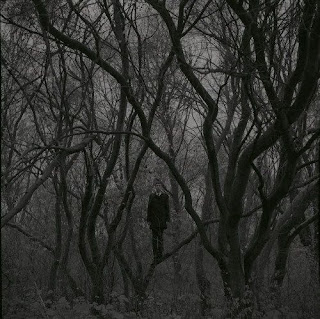The Haunted Child
 |
| Untitled, Carrie Filetti on Pinterest |
In two earlier blog posts, we were talking about (1) how Edgar
Allan Poe tells us that his childhood holds the key that unlocks “the mystery which binds me still”
and (2) how Poe often depicted his youthful self as a “child of nature.” In this post, we will complete an infancy triad
by looking at Poe’s depictions of childhood as a haunted time.
In various poems, Poe describes moments of epiphany or
revelation from his youth that foreshadow his interest in the supernatural and
the occult that would come later. The
descriptions of these experiences vary, running the gamut from simple
sensations to outright visions.
For example, in “The Lake” (1827), Poe
describes the feeling of being suddenly overcome by “terror:”
And the mystic wind
went by
Murmuring in melody
—
Then — ah! then I
would awake
To the terror of the lone lake.
If we read it literally, the episode is not out of the realm
of everyday experience. Young Poe has stayed
out at the remote “Lake” after sundown, and the passing wind has alerted him—“awoken”
him—to the reality of his situation, triggering a rush of anxiety. Except that Poe goes on to specify that the “terror was not fright, / But a tremulous
delight — / A feeling not the jewelled mine / Could teach or bribe me to define.”
In “Alone”
(1829), Poe ratchets the intensity of the perception up a notch, scaling from a
feeling to a visual, when he describes
the cloud that took
the form
(When the rest of
Heaven was blue)
Of a demon in my view.
Nevertheless, even this event, if it describes an actual
lived experience, can be contextualized as an easily explained effect of Poe’s subjective
reading of natural phenomena. After all,
we’ve all looked at clouds and seen images peculiar to our own way of
perceiving things. Probably safe to say,
though, that most people do not see demons in the sky. And there is one more detail that Poe
includes, which is to point out that the rest of the sky was blue, therefore
one which most people would find pleasant and reassuring—but he managed to find a very foreboding
sign somewhere in the corner of this bright sky.
In “Imitation”
(1827), an early variation of the poem that would become “A Dream Within A
Dream” (1849), Poe first suggests that these episodes may not have been simply
creative interpretations of ordinary experiences. First, he tells us that his “early life” was rather like “a dream.” But he adds:
I say that dream was
fraught
With a wild, and
waking thought
Of beings that have
been,
Which my spirit hath not seen
Again, taking the verses literally, as we often will, Poe is
saying that he had visions “Of beings
that have been” (i.e., the dead) whom “my
spirit hath not seen” (strangers).
Fill in a mental clip of Haley Joel Osment from The Sixth Sense (1999) (“I see dead people”), but before you
dismiss the literal reading of the lines consider Poe’s insistence that he
would not wish these visions upon any other man: “Those thoughts I would control, / As a spell upon his soul.”
And consider the culminating lines of “The Sleeper” (1831),
in which Poe recounts a child running up to an isolated tomb, “Far in the forest dim and old”, and
playfully throwing “an idle stone”
against its gates, to hear sounds resonating from inside, which are not simpy “an echo,” because,
Thrilling to think,
poor child of sin!
It was the dead who groaned within.
At face value, it would appear that there are four different
types of occurrences at play here: (1) being suddenly overcome by a strangely
thrilling fear; (2) seeing an ominous sign in a clear sky; (3) seeing visions
of dead strangers; (4) hearing the dead groaning in their graves. But, is there a single explanation that could
potentially account for all these types of haunted childhood experiences?
One possibility that comes to mind is the down-to-earth
notion that particularly creative people have active imaginations that produce
a range of mental states—and hallucinations.
John Lennon discussed his own childhood experiences in his final “Playboy Interview” (January 1981):
There was something wrong with me, I thought, because I seemed to see things other people didn't
see ... I always was so psychic or intuitive or poetic or whatever you want
to call it, that I was always seeing things in a hallucinatory way. It was scary as a child, because there
was nobody to relate to …
Surrealism had a great effect on me, because then I realized
that my imagery in my mind wasn't insanity ... Psychic vision to me is reality.
Even as a child. When I looked at
myself in the mirror or when I was 12, 13,
I used to literally trance out into alpha. I didn't know what it was called
then ... But I would find myself seeing
hallucinatory images of my face changing and becoming cosmic and complete.
(Emphasis added. Perhaps, fittingly, Lennon felt an
unexplained kinship with Poe, whose likeness was included on the cover of the
Beatles’ Sgt. Pepper album and is
mentioned in Lennon’s “I Am The Walrus” as a figure “kicked” by “element’ry penguins”—i.e.,
the simple-minded, who see everything in black and white).
Accordingly, it may be that Poe’s accounts of a haunted childhood,
while not to be taken literally or as the retellings of true-life supernatural phenomena,
have a kernel of truth more easily explained by the inner workings of a tortured
genius’ mind.




Comments
Post a Comment